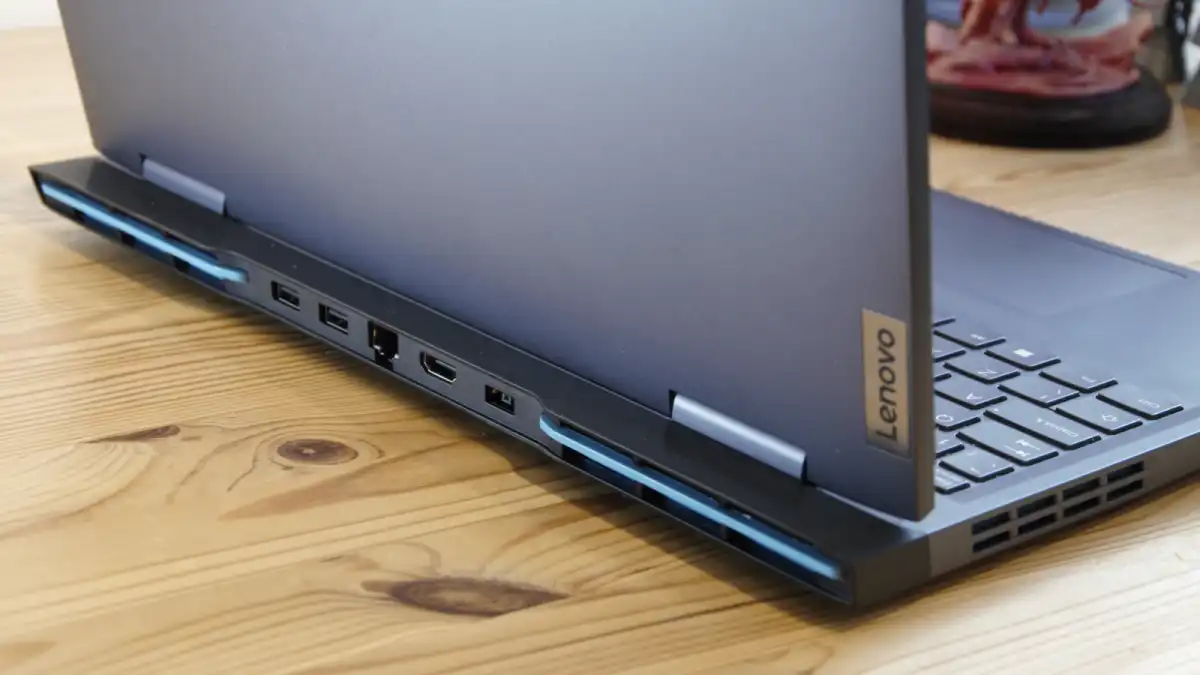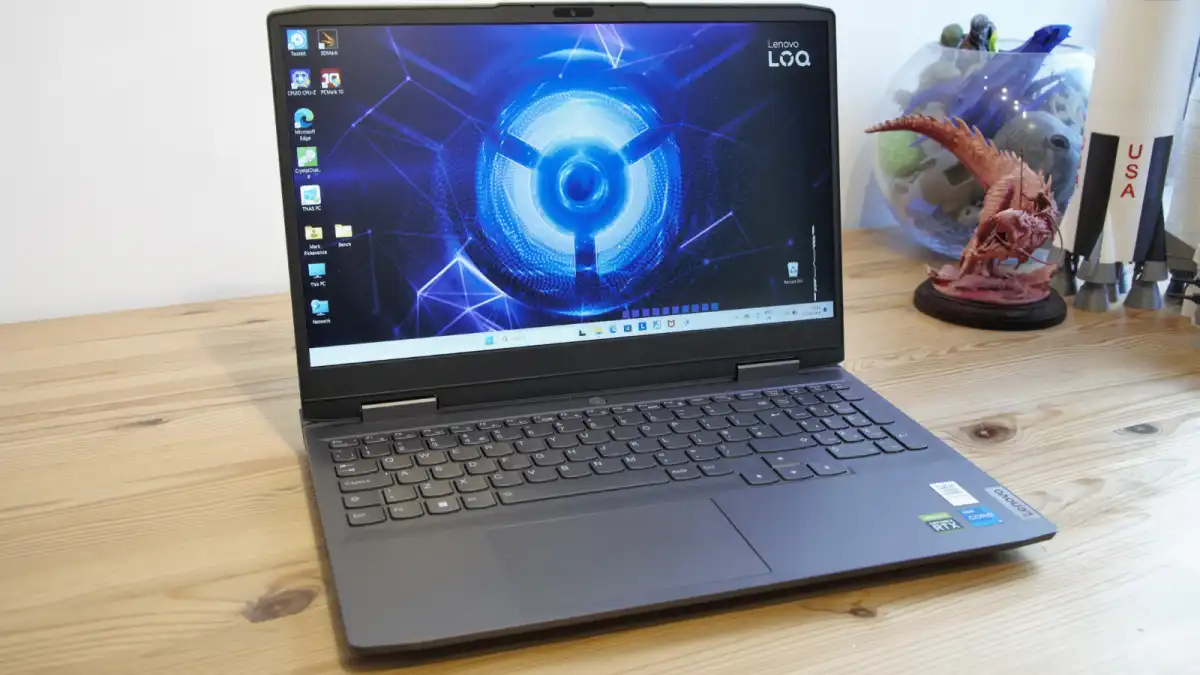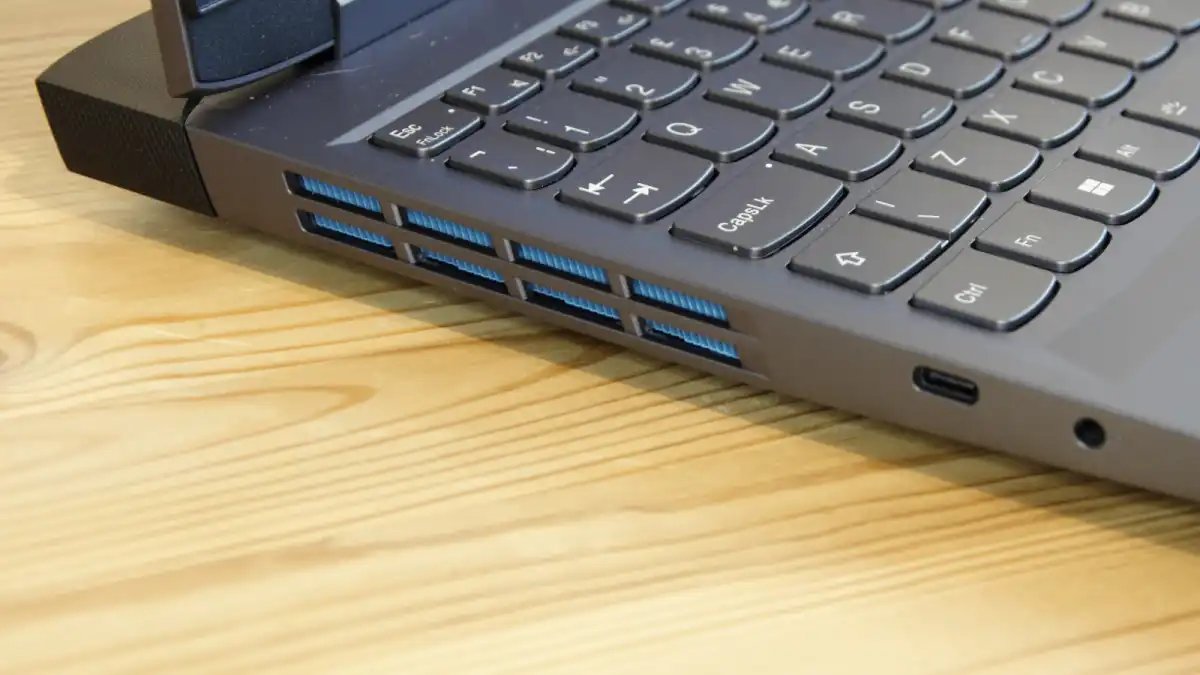One of the advantages of a PC manufacturer like Lenovo is that it does not produce a single design, and the LOQ 15-inch gaming laptop is no exception. While our study focuses on an Intel-based solution starting about $1,000, there are more powerful options and designs available, including other GPU combinations and up to 16-inch screens.
The model discussed here costs £1,069 in the UK (15IHR8), while a comparable model starts at $1,029.99 in the United States. That price gives you a 13th-generation Intel CPU, an Nvidia GeForce RTX 4060 GPU, and a 15-inch 144Hz, 1080p display. While this standard does not include 4K gaming, even when connected to an external monitor, it provides more than enough power for seamless 1080p gaming on the go.
the rear of the machine has a distinctly Star Trek vibe.
Design & Build
- Plastic on the outside
- A limited port selection that might need a docking station
- At 2.4kg, a wrist test to handle single-handed
Whereas Asus prefers a military aesthetic for their gaming machines, Lenovo has gone for a more sci-fi theme with the LOQ, and the back of the machine has a strong Star Trek flavor. The rear vents feature impulse engine styling, although Lenovo did not deploy warp nacelles.
Interestingly, the screen hinge point has been shifted roughly 23mm further from the rear line, making it simpler to access the spine’s central port region. When folded flat, it forms a noticeable ledge on the back quarter.
There is no indication of metal, with the whole outside of the LOQ coated in different hues of grey plastic. The LOQ is surprisingly weighty given how much plastic was used, yet it does not appear cheap because to the high-quality mouldings. At 2.4kg, it weighs 200g more than the Asus TUF Gaming A15 and even 50g more than the large HP Omen 16.
Where this computer falls short is in terms of available ports. It’s disappointing that a gaming system in 2024 only has one USB-C connector, with no USB 4.0 or Thunderbolt support.

The supplied port is located on the left side, near the audio jack, while the right edge includes a single USB 2.0 port and an oddly placed camera disable button.
The majority of connectors are located on the rear, although there are only two USB 3.2 Gen 2 (Type-A) ports, one HDMI 2.1 out, and a gigabit LAN port. While the LAN is not 2.5GbE, the integrated Wi-Fi meets the 2×2 AX criteria.
Ideally, this machine would have needed a second USB-C port for charging and connecting to a docking station, but Lenovo chose a unique rectangular power connector with a 170W power supply. The size of the PSU hints at why they didn’t use USB-C for power, as these normally max at approximately 100W.
Overall, the sides of the LOQ are vastly underutilized for connections, and its size makes it more of a luggable desktop with an integrated screen than a laptop. However, it has additional advantages, as we will see.
Keyboard & Trackpad
- A great keyboard feel with RGB LED lighting
- Large but unresponsive trackpad hints at using a mouse
While the keyboard in this design has a membrane construction, the size of the keys and the presence of other upgrades provide for a satisfactory typing experience.
What’s distinctive is that the cursor cluster is projected down in front of the first keyboard line, making these keys simpler to locate during a battle. However, this leaves a sliver of space between the trackpad and the spacebar.
The keytops are smaller than the others, but they still have a full numeric pad and a row of function keys.
The entire keyboard is RGB backlit, and when booting, it displays a rainbow preset to show off the chromatics available

The keys have a very positive movement, but the trackpad is significantly less sensitive, and while the pointer glides nicely, clicking on it might often go undetected. For gaming, adding mouse buttons to the trackpad may have been a better option. Lenovo feels that having a right-side USB 2.0 port indicates that most gamers will utilize a mouse.
Compared with many laptops, the LOQ is ergonomically sound. Plenty of palm space is below the keyboard, and the spacing of the keys isn’t excessively cramped. And, while the no-mans-land between the trackpad and keyboard is a little odd, it avoids bashing the space bar and having it register as a mouse movement.
Screen & Speakers
- A 1080p IPS panel at 144Hz
- Bright at maximum, but not enough for outdoor gaming
- Low-performance speakers
There are numerous panels that gaming system manufacturers are interested in, presumably owing to pricing, and the LOQ contains one of them. Using IPS technology and a natural refresh rate of 144Hz, this screen has a peak brightness of just 350 nits.
What’s interesting about the brightness is that it doesn’t rise in a linear way; the 120nits level that we use for video playback testing is approximately 70%. Those who select a brightness of 50% will experience around 50 nits, which is dim.

The hues on this panel are likewise not particularly intense or realistic. Perhaps I’ve seen too many panels built for creative usage, but even on its finest day, this one’s color gamut falls short of 100% sRGB. It can only handle around 70% of sRGB.
The audio experience is equally disappointing, since the LOQ’s two down-firing 2W speakers have a restricted range and do not offer much bass, if any. The maximum volume appears to be surprisingly low, and it is unlikely to provoke complaints from a nearby room.
In summary, if you want to improve your hearing, get some affordable external speakers or headphones.
Specs & Performance
- Intel 13th-gen processor
- Nvidia GeForce RTX 4050 or 4060 graphics
- 16GB DDR5 memory and 512GB SSD
In our review gear, the GeForce RTX 4060 stands out. This discrete graphics card contains 8GB of dedicated GDDR6 memory and the newest Nvidia GPU technology based on the Ada Lovelace architecture. In addition, there is an integrated Intel Iris Xe GPU, which we would not generally suggest for serious gaming.
Depending on the LOQ model picked, it can include either the RTX 3050, RTX 4060, or RTX 4050, and in our experience, we’d avoid the lower-level cards in favor of the far superior RTX 4060 choice.
The RTX 4060 is unique in that both the desktop and mobile versions are based on the same die, whereas these chips are frequently labeled the same but have drastically different specs.
That is true for the 4070 and 480 mobile components, but the 4060 is a desktop GPU squeezed into a laptop. However, the mobile AS107 GPU utilized in the RTX 4060 has a lower boost clock, significantly slower memory, and somewhat lower memory bandwidth.

However, the main restriction on the mobile RTX 4060 is the amount of power that the laptop will allow for the GPU, which on the desktop is always 115W, but on the mobile model fluctuates between 35W and 115W. As awful as it seems, with so many variables at play, the real difference between desktop and mobile components is just 8-10%, making the RTX 4060 one of the better options for mobile gaming.
The Intel Core i5-13500H, a twelve-core CPU with four performance P-Cores and eight efficiency E-Cores, is also a substantial contributor to these findings. The four P-Cores support hyperthreading, increasing the number of concurrent threads to sixteen. This Raptor Lake-H architecture, with a maximum power envelope of 95W and a base power of 45W, is thought to be comparable to the AMD Ryzen 5 5600X3D and Ryzen 7 5800X.
The benchmark figures generated by this GPU were previously seen in the Asus A15, and its ability to reach 90fps in Cyberpunk 2077 with extreme settings suggests that even more eye-candy, such as Ray Tracing, may be enabled without making the game unplayable.
In contrast, users who utilize the LOQ with a 1440p display will find that the RTX 4060 is capable of driving that resolution at medium detail settings.
The 3DMark Night Raid score of 51,283 is impressive, especially when contrasted to this processor’s integrated Iris Xe, which typically achieves a score between 16,500 and 17,000.
While 16GB of RAM is plenty, given that the graphics card has its own dedicated memory, the LOQ is significantly let down by the 512GB of storage that Lenovo supplies with most configurations.
However, for those prepared to remove the underbelly of their laptop, a free and unused M.2 SSD slot is accessible, providing for a reasonably modest upgrade option (see our list of the best SSDs). These are both M.2 2280 PCIe 4.0 slots, and the only restriction is that they must be drives without an integrated cooling, as there is no vertical room within the casing for them.
Lenovo LOQ 15 benchmarks
Battery Life
- 60Wh battery
- Poor lifespan
- Fast recharge
The problem with putting a powerful processor and a demanding GPU in a laptop is that they demand plenty of power. Unless the machine has a huge battery, it will eat through what’s available in short order. And when I say ‘short’, I’m not kidding.
the battery will recharge quickly, hitting 100% power from almost exhaustion in over an hour
Using our standard battery video loop, the LOQ only made it through one loop of our movie before deciding to power down, lasting 3 hours and 58 minutes. Based on this performance, I think that playing a game would only last a few hours on batteries.
Lenovo claims a battery life of more than 5 hours, which is outrageously optimistic. The system also has a high-performance mode, which, when enabled, decreases battery life even further.
The one advantage to its less-than-stellar battery performance is that it recharges swiftly, reaching 100% power from nearly empty in over an hour. However, if you insist on using it while charging, it may take longer.

Price & Availability
In the US and UK, the Lenovo LOQ 15 comes with either an RTX 3050, RTX 4050 or RTX 4060 discrete video. Lenovo does the typical combination of pre-configured SKUs and completely customisable systems where almost every aspect is adjustable.
For UK customers, the processor options include the i5-13450HX, i7-136050 and the i7-14700HX. Memory can be 8GB, 12GB or 16GB. Storage starts with 512GB with 1TB options. Where most LOQs come with the 1080p display seen in our review, there is also a 1440p panel, but both are non-touch.
US prices start at only $1,209.99 for a LOQ with the i5-13500H CPU, RTX 3050 GPU, 8GB of RAM and 512GB of storage. A system with RTX 4060 graphics starts at $1,319.99. American customers also get the option for AMD Ryzen models from $949.


